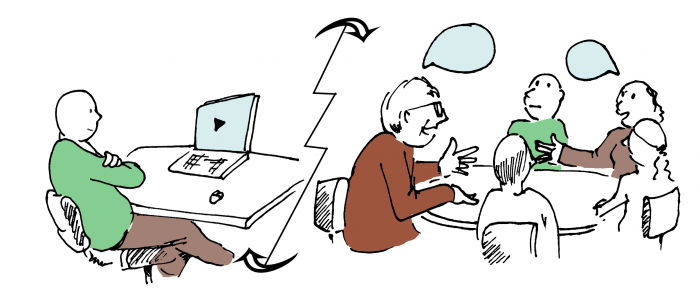Teacher: Rikke Langebæk
 “Flipping” her classroom allowed Rikke to improve the educational material for her course, Basic Surgical Skills, by adding instructional videos and making the material available for preparation and revision on demand. For Rikke it meant that the valuable but limited time that was previously spent on giving lectures became freed up for practical sessions in the clinic. Now she can spend her time working with the students and following each individual closely.
“Flipping” her classroom allowed Rikke to improve the educational material for her course, Basic Surgical Skills, by adding instructional videos and making the material available for preparation and revision on demand. For Rikke it meant that the valuable but limited time that was previously spent on giving lectures became freed up for practical sessions in the clinic. Now she can spend her time working with the students and following each individual closely.

The opportunity for the students to repeatedly view and listen to the lectures and videos has made them more confident and increased their satisfaction with the practical sessions in the clinic. So the flipped-classroom model has had a motivating effect and resulted in a better outcome for students and teachers alike.
Today, Rikke would not even consider going back to regular lecturing, as both she and her students are enjoying the course more than ever.
What was your motivation?
“Before, we spent much of our 10-day course lecturing on clinical and surgical theory in the classroom. It was dull for both the teachers and students. We had to find a way to use our time more efficiently so we could use our time with the students on practical instruction in the clinic instead.”
How did you get started?
“The idea of flipping the classroom came up before the word was even invented – at least as far as I knew. It came out of a dissatisfaction with the way we spent our time, using the ‘confrontation theory’ instead of on the much-desired hands-on sessions. We had the Absalon platform and thought: why don’t we narrate our theoretical Power Point presentations and produce a lot of instructional videos and upload them there? This would free up time for all the fun stuff and save us having to repeat the same lectures ad infinitum. So we asked the IT Learning Centre at UCPH if that was possible, and together we developed the first rough version of a flipped classroom.”
How did it go?
“We spent a lot of time actually producing the presentations, videos and quiz questions, and because this was new territory for all of us, we made a lot of mistakes to begin with. For instance, the original video player turned out to be quite slow and not compatible with Mac computers, so it took some time before we had the final result. I myself have no knowledge about computers or programming, and I’m extremely grateful that I got to work with the patient people at the IT Learning Centre.”
What was the outcome for you - and the students?
“It gave me time to answer all the questions that come up in the clinic, no matter how silly they may seem, because I was one-on-one with the students. In short, I could do the things I wanted to do – giving the students feedback and helping them overcome obstacles instead of spending time preparing for the same lectures over and over.
“The students felt much better prepared for the clinic sessions. Having the opportunity to repeatedly watch the videos before and during class gave the student more confidence when they were in the clinic. Even better, it gave the students several more days of clinical practice, which is extremely valuable when battling the anxiety and stress that can occur in the clinic.”
How much time did you spend on it?
 “Well, initially it does take some time to prepare, record, narrate and edit your lectures and videos. But as I look back now, it feels more like an investment in my course, as I can focus more on the clinical work now that I no longer have to prepare for the theoretical lectures.”
“Well, initially it does take some time to prepare, record, narrate and edit your lectures and videos. But as I look back now, it feels more like an investment in my course, as I can focus more on the clinical work now that I no longer have to prepare for the theoretical lectures.”
 “Flipping” her classroom allowed Rikke to improve the educational material for her course, Basic Surgical Skills, by adding instructional videos and making the material available for preparation and revision on demand. For Rikke it meant that the valuable but limited time that was previously spent on giving lectures became freed up for practical sessions in the clinic. Now she can spend her time working with the students and following each individual closely.
“Flipping” her classroom allowed Rikke to improve the educational material for her course, Basic Surgical Skills, by adding instructional videos and making the material available for preparation and revision on demand. For Rikke it meant that the valuable but limited time that was previously spent on giving lectures became freed up for practical sessions in the clinic. Now she can spend her time working with the students and following each individual closely.


 “Well, initially it does take some time to prepare, record, narrate and edit your lectures and videos. But as I look back now, it feels more like an investment in my course, as I can focus more on the clinical work now that I no longer have to prepare for the theoretical lectures.”
“Well, initially it does take some time to prepare, record, narrate and edit your lectures and videos. But as I look back now, it feels more like an investment in my course, as I can focus more on the clinical work now that I no longer have to prepare for the theoretical lectures.”